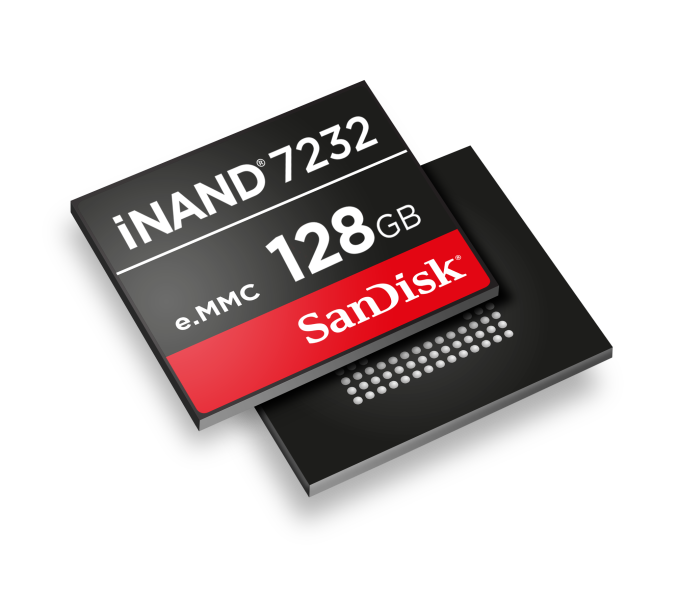SanDisk Announces iNAND 7232: eMMC 5.1, 128GB, and SLC/TLC
by Joshua Ho on July 13, 2015 9:00 AM EST- Posted in
- Smartphones
- SanDisk
- Mobile
- Tablets
- eMMC
- iNAND Extreme

Today at MWC Shanghai, SanDisk announced a follow-up to their iNAND 7132 eMMC solution, the iNAND 7232. For those that are unfamiliar with the iNAND 7132, I would refer to our previous coverage on that storage solution. At a high level, the real importance of that product launch was that SanDisk was able to use TLC NAND to provide relatively low-cost storage with high performance using SLC caching much like their consumer SSDs. Peak sequential reads on the earlier 7132 series could reach 280 MB/s, and peak sequential writes also reached 125 MB/s on an eMMC 5.0 HS400 interface. There were 16, 32, and 64 GB SKUs which didn’t do much to push the bar in terms of on-device storage, but there are some real cost and performance benefits for certain scenarios that could provide an advantage over traditional MLC eMMC solutions at the high end which would go a long way to killing the 16GB SKU that has plagued the high-end smartphone for so long.
The iNAND 7232 is an obvious successor to the 7132, as it’s built on SanDisk’s 15nm process with TLC NAND and an SLC cache somewhere in the range of 500MB to 1GB, but this will depend upon the SKU. However, unlike the 7132 SanDisk has finally eliminated the 16GB SKU so the only available storage capacities are 32, 64, and 128 GB. This new solution also supports eMMC 5.1 with a command queue to improve random IO read speeds. Sequential read speeds are unchanged with a maximum of 280 MB/s, but sequential write improves to hit up to 150 MB/s from the 125 MB/s on the 7132. The iNAND 7232 is currently sampling to OEMs, and it’s likely that we’ll see devices shipping with this solution in the fall.










25 Comments
View All Comments
Flunk - Monday, July 13, 2015 - link
Why bother, all phones have been TLC for ages.extide - Monday, July 13, 2015 - link
TLC has been used in USB flash chips and stuff like eMMC phone storage for quite some time. The performance requirements of such devices are a LOT lower and the performance issues with the samsung 840 series drives don't really affect these situations as much.LordConrad - Monday, July 13, 2015 - link
I suppose it's true that most people don't write nearly as much data to their phone as they would to a PC, but what about the read errors caused by voltage shifting that occurred in the 840 EVO? That could happen in a phone also, couldn't it?Stochastic - Monday, July 13, 2015 - link
Random, semi-related question: to what extent are app launch times bottlenecked by NAND these day? How much of a day-to-day subjective performance advantage does UFS 2.0 offer?Impulses - Tuesday, July 14, 2015 - link
I think that can vary wildly by app and how they store data... I've got a package tracking app, about the simplest thing possible, that has become the slowest loading app over time on my Nexus 5, it's literally cringe inducing. Wiping the delivery history fixes it so it's obviously massively bottlenecked and/or poorly written.